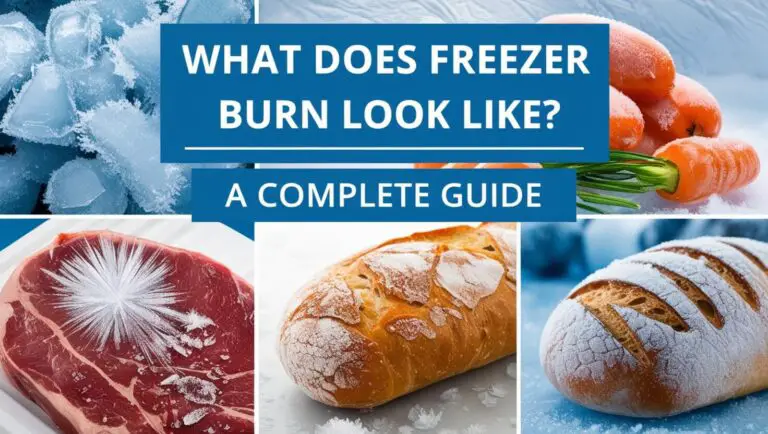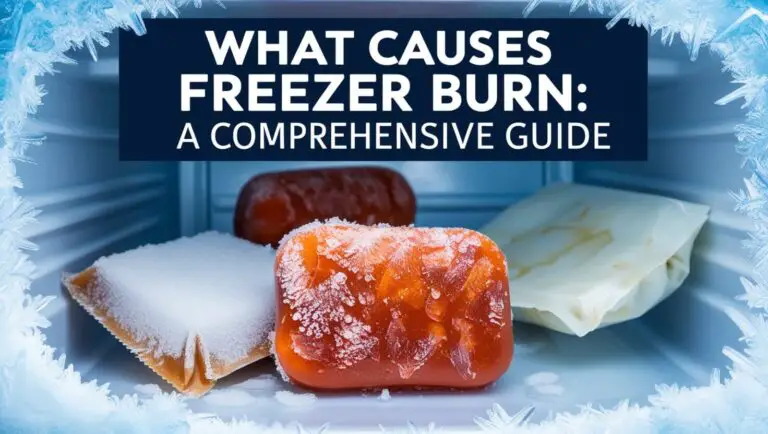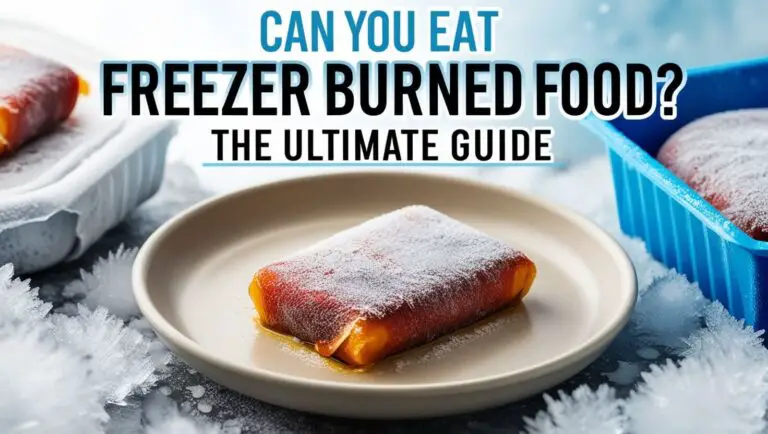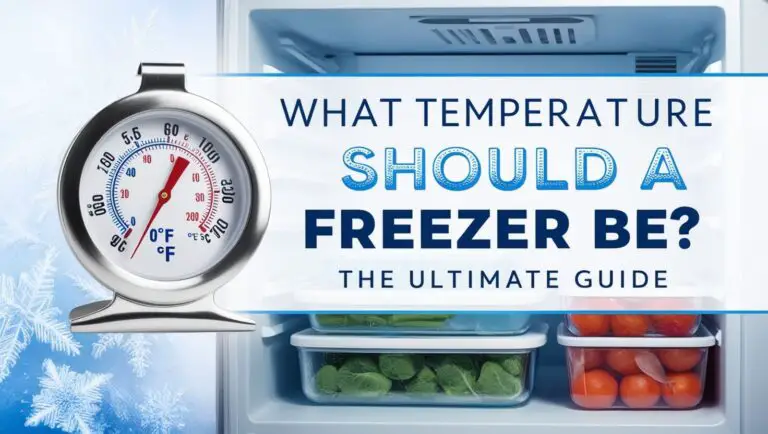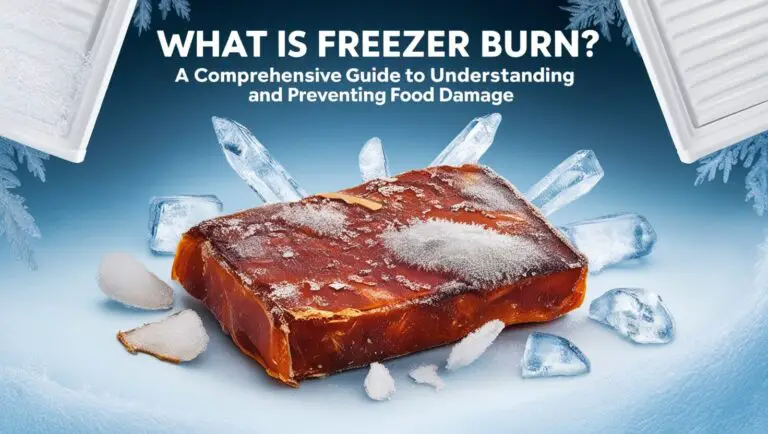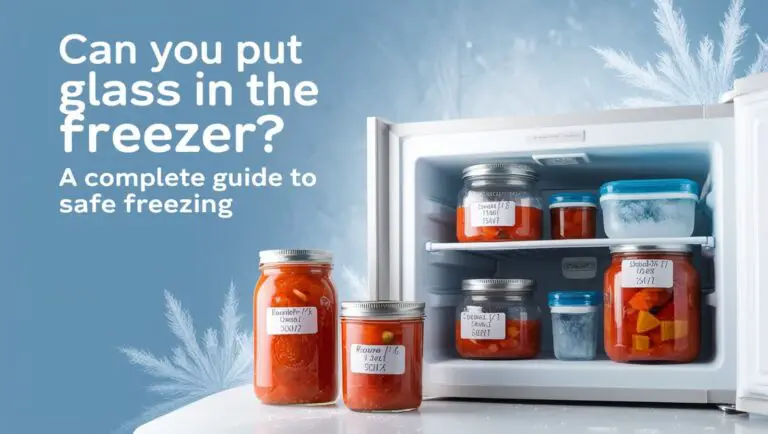Is Freezer Burn Bad? Preventing Icy Food Damage
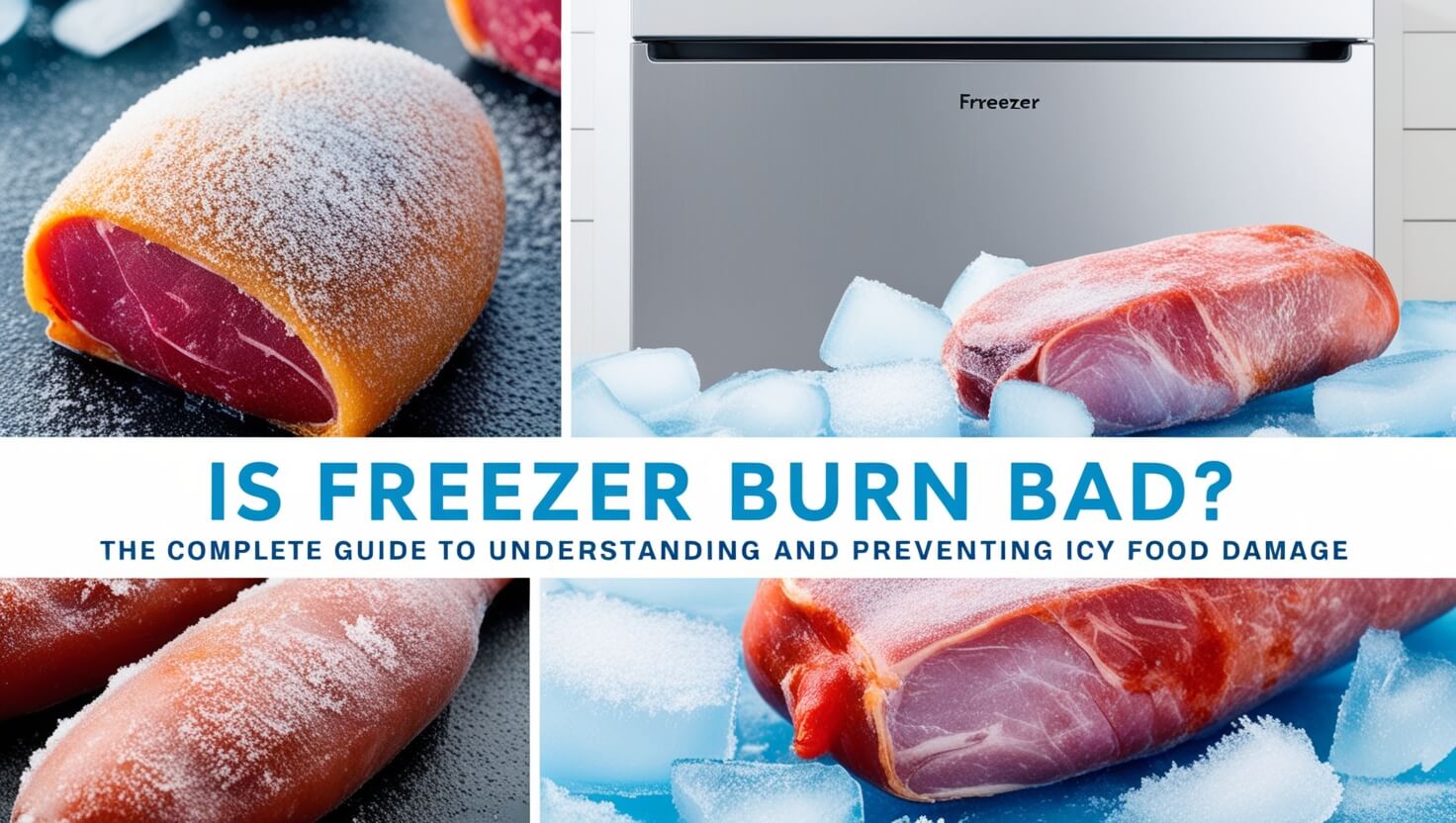
Have you ever opened your freezer to find your favorite foods covered in ice crystals or looking discolored? That’s freezer burn, and it’s a common issue many of us face. But is freezer burn bad? The short answer is: while it’s generally safe to eat freezer-burned food, it can affect taste and texture. Let’s dive into the icy world of freezer burn and learn how to keep our frozen foods fresh and delicious.
What Exactly Is Freezer Burn?
Freezer burn is a condition that occurs when frozen food loses moisture. It’s not a sign of spoilage, but rather a result of air exposure in the freezer. When food isn’t wrapped properly, water molecules escape from the food and form ice crystals on its surface.
The Science Behind Freezer Burn
The process behind freezer burn is called sublimation. This happens when water changes directly from a solid to a gas, skipping the liquid phase. In your freezer, the ice in your food turns into water vapor, which then refreezes on the surface of the food or packaging.
How Freezer Burn Affects Different Foods
Freezer burn doesn’t play favorites – it can affect any food in your freezer. However, some foods are more susceptible than others:
- Meat and poultry: These often show gray or brown spots when freezer-burned.
- Fruits and vegetables: They may become shriveled and covered in ice crystals.
- Ice cream: It can develop a gritty texture and lose its creamy consistency.
- Bread: Freezer-burned bread often becomes dry and tough.
Identifying Freezer Burn: Visual Clues and Texture Changes
Knowing what to look for can help you spot freezer burn early. Let’s explore the telltale signs.
Ice Crystals and Discoloration: Tell-Tale Signs
The most obvious sign of freezer burn is the presence of ice crystals on your food. You might also notice:
- White, grayish-brown, or gray spots on meat
- Dulled colors in fruits and vegetables
- A frosty coating on ice cream or other frozen desserts
Texture Alterations in Freezer-Burned Foods
Freezer burn doesn’t just change how food looks – it affects texture too. Here’s what you might notice:
- Meat becomes tough and leathery
- Vegetables turn mushy when cooked
- Ice cream loses its smooth texture and becomes grainy
- Bread feels dry and crumbly
Is Freezer-Burned Food Safe to Eat?
Now for the big question: is freezer burn bad for your health? Let’s separate fact from fiction.
Safety Concerns: Separating Fact from Fiction
Good news! Freezer-burned food is generally safe to eat. The process of freezer burn doesn’t introduce any harmful bacteria or pathogens. However, it’s important to note that while freezer burn itself isn’t dangerous, it could be a sign that your food has been in the freezer for too long, potentially affecting its overall quality.
Nutritional Impact of Freezer Burn
While freezer burn doesn’t make food unsafe, it can affect its nutritional value. The dehydration process can lead to some loss of vitamins and minerals. However, the impact is usually minimal, especially if you consume the food soon after noticing the freezer burn.
How Freezer Burn Affects Taste and Quality
While freezer-burned food won’t make you sick, it might not be the most pleasant eating experience. Let’s look at how it affects flavor and texture.
Flavor Changes in Freezer-Burned Foods
Freezer burn can significantly alter the taste of your food:
- Meat often develops a gamey or off-flavor
- Fruits and vegetables might taste bland or have an odd, freezer-like taste
- Ice cream can lose its sweetness and develop a stale flavor
Texture Deterioration: From Juicy to Dry
The most noticeable effect of freezer burn is often in the texture:
- Meats become dry and tough
- Fruits and vegetables turn mushy or grainy
- Ice cream loses its creaminess and becomes icy
- Bread and baked goods become dry and crumbly
Common Culprits: Foods Most Susceptible to Freezer Burn
While any food can get freezer burn, some are more prone to it than others. Understanding which foods are at higher risk can help you take extra precautions.
High Moisture Content Foods at Risk
Foods with high water content are particularly vulnerable to freezer burn. These include:
- Fruits like berries, melons, and peaches
- Vegetables such as zucchini, tomatoes, and leafy greens
- Meat, especially cuts with less fat
- Fish and seafood
The higher water content in these foods means more moisture can escape, leading to more severe freezer burn.
Surprising Items That Can Get Freezer Burn
Some foods you might not expect can also fall victim to freezer burn:
- Nuts and seeds: Their oils can oxidize, leading to a rancid taste
- Coffee beans: They can lose their aroma and flavor
- Spices: Ground spices can clump and lose potency
- Flour: It can absorb odors and develop a stale taste
Preventing Freezer Burn: Best Practices for Food Storage
Now that we know what freezer burn is and how it affects our food, let’s look at ways to prevent it. With the right techniques, you can keep your frozen foods fresher for longer.
Proper Packaging Techniques
The key to preventing freezer burn is minimizing air exposure. Here are some effective packaging methods:
- Vacuum sealing: This is the gold standard for freezer storage. It removes all air, significantly reducing the risk of freezer burn.
- Double wrapping: For items like meat or bread, wrap tightly in plastic wrap, then place in a freezer bag.
- Airtight containers: Use containers specifically designed for freezer use. They should have tight-fitting lids to keep air out.
- Aluminum foil: For short-term storage, heavy-duty aluminum foil can be effective, especially for oddly shaped items.
- Freezer paper: This is great for wrapping meat. The waxy side goes against the meat, creating a tight seal.
Remember to squeeze out as much air as possible before sealing bags or containers.
Optimal Freezer Temperature Settings
Your freezer’s temperature plays a crucial role in preventing freezer burn. Here’s what you need to know:
- Ideal temperature: Set your freezer to 0°F (-18°C) or below. This temperature stops bacterial growth and slows down enzymatic reactions that can lead to food spoilage.
- Consistent temperature: Avoid frequent or prolonged temperature fluctuations. Every time you open the freezer door, the temperature rises slightly. Try to minimize how often and how long you keep the door open.
- Use a thermometer: Place a freezer thermometer in your freezer to ensure it’s maintaining the correct temperature.
How Long Can You Safely Store Foods in the Freezer?
While freezing can extend the shelf life of food significantly, it doesn’t preserve food indefinitely. Understanding storage times can help you use your frozen foods at their best quality.
General Guidelines for Frozen Food Storage
Here are some general guidelines for common foods:
- Ground meat: 3-4 months
- Steaks, chops: 4-12 months
- Whole chicken or turkey: 1 year
- Fish: 3-8 months
- Fruits and vegetables: 8-12 months
- Bread: 2-3 months
- Cooked leftovers: 2-6 months
Remember, these are quality guidelines. Frozen foods remain safe indefinitely, but quality decreases over time.
Signs It’s Time to Toss Frozen Items
While freezer burn itself isn’t a reason to discard food, there are signs that indicate it’s time to say goodbye:
- Severe discoloration or dark spots on meat
- Strong, unpleasant odors after thawing
- Ice crystals covering more than 50% of the item
- Visible signs of freezer burn combined with being well past the recommended storage time
When in doubt, trust your senses. If something looks or smells off after thawing, it’s better to be safe and throw it out.
Salvaging Freezer-Burned Food: Tips and Tricks
If you’ve discovered some freezer-burned food, don’t despair! In many cases, you can still use it with a few clever tricks.
Cooking Methods to Improve Taste and Texture
- Trimming: For meats with freezer burn, trim off the affected areas before cooking.
- Slow cooking: Using methods like braising or slow cooking can help rehydrate dry, freezer-burned meats.
- Seasoning: Use stronger seasonings or marinades to mask any off-flavors from freezer burn.
- Pureeing: For fruits and vegetables, consider pureeing them for use in smoothies or soups.
- Breading: Coating freezer-burned fish or chicken in breadcrumbs can help improve texture.
Creative Uses for Slightly Freezer-Burned Items
- Soups and stews: Use freezer-burned vegetables or meats in hearty soups where texture changes are less noticeable.
- Baking: Slightly freezer-burned fruits can be used in muffins, pies, or cobblers.
- Casseroles: Mix freezer-burned meats or vegetables into casseroles with sauces and cheese.
- Pet food: If the freezer burn is mild, consider using the food in homemade pet meals (consult your vet first).
- Compost: If the food is too far gone for human consumption, it can still be useful in your compost bin.
Debunking Freezer Burn Myths
There’s a lot of misinformation out there about freezer burn. Let’s set the record straight on some common myths.
Common Misconceptions About Freezer Burn
Myth 1: Freezer burn is caused by food being frozen for too long. Truth: While long storage can increase the risk, freezer burn is caused by exposure to air, not time alone.
Myth 2: Freezer-burned food will make you sick. Truth: Freezer burn doesn’t introduce harmful bacteria. It’s a quality issue, not a safety one.
Myth 3: You can prevent freezer burn by lowering the freezer temperature. Truth: While proper temperature is important, it won’t prevent freezer burn if food isn’t properly wrapped.
Myth 4: All ice crystals on food indicate freezer burn. Truth: Some ice formation is normal. Extensive ice crystals or changes in color and texture are signs of freezer burn.
The Truth About Refreezing Thawed Foods
There’s often confusion about whether it’s safe to refreeze thawed foods. Here’s the truth:
- If food was thawed in the refrigerator and hasn’t been at room temperature for more than 2 hours, it’s generally safe to refreeze.
- However, refreezing can affect quality, especially texture.
- Never refreeze food that was thawed at room temperature or in the microwave unless it’s been cooked first.
- Refreezing raw meats is safe if they still contain ice crystals.
Remember, while refreezing is often safe, it can increase the risk of freezer burn and affect food quality.
The Environmental and Economic Impact of Freezer Burn
Freezer burn isn’t just a nuisance – it can have broader impacts on our wallets and the environment.
Food Waste and Its Consequences
When freezer burn makes food unpalatable, it often ends up in the trash. This contributes to the larger problem of food waste:
- In the United States alone, 30-40% of the food supply goes to waste.
- Food waste in landfills produces methane, a potent greenhouse gas.
- Wasted food also means wasted resources used in production, packaging, and transportation.
By preventing freezer burn, we can do our part to reduce food waste and its environmental impact.
Cost-Saving Strategies to Minimize Freezer Burn
Preventing freezer burn isn’t just good for the environment – it’s good for your budget too. Here are some strategies:
- Invest in quality storage containers and vacuum sealers. The upfront cost can save money in the long run by preserving food better.
- Plan your meals and only freeze what you’ll use in a reasonable time frame.
- Label everything with contents and date. Use the “first in, first out” method to rotate your frozen foods.
- Consider a chest freezer for long-term storage. They maintain temperature better than upright freezers when opened.
- Regularly clean and organize your freezer. This helps you keep track of what you have and use items before they develop freezer burn.
Advanced Freezing Techniques for Long-Term Storage
For those serious about preserving food quality in the freezer, there are some advanced techniques worth considering.
Blast Freezing: What It Is and How It Helps
Blast freezing is a method used in commercial food production that can be adapted for home use:
- It involves freezing food very quickly at extremely low temperatures.
- This rapid freezing forms smaller ice crystals, which cause less damage to food cells.
- The result is better texture and quality upon thawing.
While industrial blast freezers aren’t practical for home use, you can mimic the effect:
- Spread food items in a single layer on a baking sheet.
- Place the sheet in the coldest part of your freezer.
- Once frozen solid, package the food for long-term storage.
This method works particularly well for berries, diced vegetables, and individual portions of meat.
Vacuum Sealing: A Game-Changer for Frozen Foods
Vacuum sealing is one of the most effective ways to prevent freezer burn:
- It removes air from the packaging, significantly reducing the risk of oxidation and moisture loss.
- Foods vacuum-sealed before freezing can last 2-3 times longer than those stored in conventional freezer bags.
- It’s especially beneficial for meats, which are prone to freezer burn.
Tips for effective vacuum sealing:
- Pre-freeze soft or moist foods before sealing to prevent crushing and excess moisture.
- Leave enough space at the top of the bag for a good seal.
- For items with sharp edges (like bones), wrap them in paper towel or parchment paper to prevent puncturing the bag.
When to Be Concerned: Beyond Freezer Burn
While freezer burn itself isn’t harmful, there are times when you should be cautious about consuming frozen foods.
Signs of Spoilage in Frozen Foods
Even frozen foods can go bad. Watch out for these signs:
- Rancid odors: If it smells bad when thawed, it’s likely spoiled.
- Changes in color: Discoloration beyond freezer burn could indicate spoilage.
- Sticky or slimy texture: This is a sign of bacterial growth.
- Mold: If you see any mold, discard the food immediately.
When to Trust Your Senses Over Expiration Dates
Expiration dates on frozen foods are more about quality than safety. Here’s when to rely on your senses:
- If food looks and smells normal upon thawing, it’s likely safe to eat, even if past the “best by” date.
- However, if something seems off, trust your instincts and discard it.
- Remember that freezing extends shelf life but doesn’t improve quality. If food was near expiration when frozen, it won’t be at its best when thawed.
Freezer Organization: Maximize Space and Minimize Burn
A well-organized freezer not only makes your life easier but also helps prevent freezer burn by ensuring proper air circulation and easy access to items.
Efficient Freezer Layout Strategies
- Zone your freezer: Designate areas for different types of food (meats, vegetables, prepared meals, etc.).
- Use clear containers: This makes it easy to see what’s inside without opening.
- Avoid overpacking: Leave some space between items for air circulation.
- Keep frequently used items in front: This minimizes the time the freezer door is open.
- Use freezer-safe baskets: These can help corral smaller items and make them easier to access.
Labeling and Rotation Systems for Frozen Foods
Proper labeling and rotation are key to preventing freezer burn and reducing waste:
- Label everything: Include the contents and date frozen.
- Use a color-coding system: Assign colors to different types of food or months frozen.
- Implement a “first in, first out” system: Place newer items in the back and move older ones to the front.
- Keep an inventory: Maintain a list of what’s in your freezer and update it regularly.
- Set reminders: Use your phone or a calendar to remind you to use items before they’re likely to develop freezer burn.
In Summary: Embracing Proper Freezing Practices for Better Food Quality
So, is freezer burn bad? While it’s not a food safety issue, it can certainly impact the quality of your frozen foods. By understanding what causes freezer burn and how to prevent it, you can ensure that your frozen foods remain tasty and nutritious for longer periods.
Let’s recap the key points we’ve covered:
- Freezer burn is caused by moisture loss and air exposure, not by bacterial growth.
- While freezer-burned food is safe to eat, it may have compromised taste and texture.
- Proper packaging, consistent freezer temperature, and organized storage are crucial in preventing freezer burn.
- Different foods have varying susceptibility to freezer burn and optimal storage times.
- With some creativity, you can often salvage freezer-burned foods.
- Preventing freezer burn not only improves your food quality but also reduces waste and saves money.
By implementing the strategies we’ve discussed – from vacuum sealing to blast freezing, from proper organization to regular rotation – you can significantly reduce the occurrence of freezer burn in your home.
Remember, your freezer is a valuable tool for preserving food and reducing waste. By taking care to prevent freezer burn, you’re not just ensuring better meals for yourself and your family; you’re also contributing to a more sustainable food system.
As we wrap up, here are some final thoughts to keep in mind:
- Don’t be afraid of your freezer. With proper techniques, frozen foods can retain their quality and nutritional value for months.
- Be mindful of what you freeze. Not all foods freeze well, so choose wisely.
- Make freezer management a regular part of your kitchen routine. A little effort goes a long way in maintaining food quality.
- When in doubt, use your senses. If something doesn’t look or smell right after thawing, it’s better to be safe and discard it.
- Consider investing in quality freezer storage solutions. The initial cost can pay off in reduced food waste and better-tasting meals.
By understanding freezer burn and taking steps to prevent it, you can make the most of your frozen foods, reduce waste, and enjoy high-quality meals all year round. So the next time you reach into your freezer, you can do so with confidence, knowing that you’ve taken the necessary steps to keep freezer burn at bay.
Remember, a well-managed freezer is not just about preventing freezer burn – it’s about preserving flavors, saving time, and making the most of your food resources. With these tips and techniques in your culinary arsenal, you’re well-equipped to master the art of freezer storage and enjoy delicious, well-preserved foods whenever you need them.
Happy freezing!

